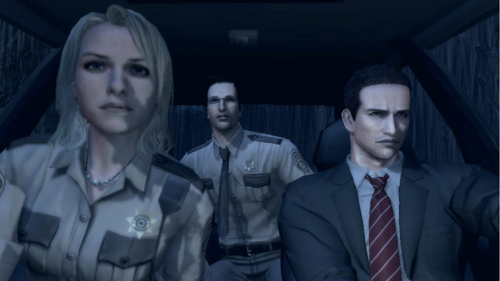《致命预感》负责人在GDC上分享设计精彩情节的7种方法
2010年,《致命预感》让那些搜寻深故事性单人游戏的玩家眼前一亮,也在年末获得众多媒体好评。在GDC 2011上,《致命预感》负责人Hidetaka “Swery” Suehiro回顾其制作出令玩家印象深刻的故事的7个要点。
1、让玩家在游戏中边玩边思考
将游戏中的行为与玩家在现实生活中的行为联系起来。Suehiro说道:“许多烟民玩家说过,当他们看到York在游戏中吸烟时,也很想在卧室中点上一根。睡眠、饥饿、剃须、保洁,这些东西咋看之下并非游戏必要元素,但确实能带来意想不到的效果。”游戏邦觉得,开发人员需要把玩家在游戏中的印象与现实世界中的行为联系起来作为目标。
据Suehiro所述,他喜欢在游戏中体现人类的日常需求,因为这些会对屏幕外的玩家产生影响。诸如喝咖啡时的预言和角色谈论的电影等“玩乐元素”使玩家感同身受。他说道:“玩家还曾经告诉我们,他们去租York在汽车中谈论过的电影碟片。”这些情节会不停地在玩家脑中徘徊。
2、精心编写故事,让玩家主动选择游戏
不好的故事情节会使玩家厌烦,觉得自己是被迫在玩游戏。Suehiro说道:“游戏中的种种限制使玩家感觉自己被强迫做某件事情。如何才能让玩家在游戏中得到解放呢?如何才能让玩家主动打通游戏?”目前已有两种方法:设置多种结局和设计故事主线外的探索。《致命预感》别出心裁地采用了新方法“自由选择”,允许玩家在游戏中任何时候停止正在进行的探索并选择另一条路线,为玩家打造自由的感觉。他说道:“只要玩家感到舒适,他们就更愿意投入剧情中。”
在包括前作《Spy Fiction》在内的其他游戏中,如果玩家任务失败便会遭到指责。在《致命预感》中,主角York会根据玩家的指示来改变自己的意见。当York脱离故事主线,按自己的线路发展时,玩家觉得这正符合他们的想法。事实上,故事中的角色以自身经历告诉玩家,时机才是最重要的,而并非速度。
游戏邦觉得,该游戏的目标在于使玩家参与到故事发展中。为达目的,玩家可在任何时候重新做出选择,游戏完全支持玩家的想法,并根据玩家的想法对故事做相应改动。由于做出的决定能够得以实现,玩家感觉自己有权更改游戏情节。
3、在自由开放的游戏世界背景下设计故事情节
Suehiro说道:“我们要在游戏中设计出独特的角色和事物。”过于普通的角色很难深深扎根于玩家心中。在设计故事情节时,通常都是在完成主线情节的前提下,才开始规划游戏世界的地图和角色的诸多细节。《致命预感》的开发人员反其道而行,先制定故事摘要,然后是地图和角色细节,接下来是每个角色日常24小时的生活时间表。等所有这些完成后,才轮到剧情的设计。
他说道:“事物、环境、角色和故事情节同样重要,尤其当游戏世界自由开放时。数年前,当我们开始制作这款游戏时,并没有许多故事情节供我们参考,因此才想出这种方法。”
4、防止玩家在结束动画时退出游戏
据游戏邦了解,任何将“促使玩家通关”置于“促进玩家了解更多故事”之上的游戏都已相继被淘汰。游戏过程中每个剧情暂停的地方,如结束动画或每章的末尾处,玩家都可能会退出游戏。
Suehiro说道:“我们在结束动画前插入下一个挑战目标,吸引玩家探索后续剧情。”但是,对像大型开放世界游戏《辐射》系列中省略结束动画和场景的做法,他并没有发表评论。
5、设计出魅力十足的角色
Suehiro说道:“如果玩家丝毫记不起游戏中任意角色的名字,那么这就不是个好游戏。”记录下你可以想到的要在角色上表达的信息,并将其运用于角色开发中,那么这些角色才可能被玩家记住。他说道:“开发者应该花大量时间构想角色深层次的性格,这的确有益于每个角色的制定。”
他在脑海中构建每个角色的大体框架,包括习惯、爱好、角色的初恋等等。Suehiro认为,角色的口头禅和姿态同样也很重要,因为玩家很容易回忆起这些内容。他说道:“这些很重要,玩家可能会模仿角色的姿态和用语。因此,角色身上的这些元素必须设计成可供玩家模仿的类型。”
他承认自己所设计主角的姿态和口头禅稍微有点特立独行,可以更自然些。最重要的是,角色身上必须兼具优点和缺点。以York为例,虽外表俊朗,但缺乏人际交往也不会体谅他人。据游戏邦了解,游戏中每个角色都有突出的优点,但也潜藏着某些不足之处。他说道:“让游戏设计师为自己的角色塑造缺点确实很有难度,毕竟他们希望每个人都会喜欢自己勾画出的角色。”但事实上,略带瑕疵的角色更能够为玩家所接受。
6、恰到好处的配音
角色说话的方式最好能令玩家印象深刻。如何才能在配音中恰到好处地表现出角色不懂英语这个背景呢?Suehiro提到曾跟配音演员探讨过音乐和游戏主题。角色York的声音中带有利物浦和英国本土腔调。他说道:“我对如何说出台词的方式尤为关注,包括韵律等。我还研究过音乐在场景中所起的作用。开发者需要为配音制定一套规则。”
7、无时不刻融入自己的想法
Suehiro说道:“最重要的便是开发者的想法。”只要有机会,开发人员应该尽量融入自己的想法。玩家或许不会察觉到游戏中融入的所有想法,不过一旦他们注意到,这些潜藏着的想法会自然涌进玩家心中。他说道:“开发者应当无时不刻地在游戏中融入自己的想法,而不是将其集中在某些情节里。”举个例子,格林韦尔镇便是游戏中Dalmatian的原型。
最后,Suehiro总结道:“如果有机会,我还想为全球用户制作出与前作相比有巨大飞跃的游戏。”(本文为游戏邦/gamerboom.com编译,转载请注明来源:游戏邦)
GDC 2011: Deadly Premonition’s 7 Steps To A Memorable Story
In 2010, Deadly Premonition was a surprise hit among players searching for a deep narrative single player game, and went on to win over a dozen end of the year awards from a variety of media outlets. At GDC 2011, Deadly Premonition director Hidetaka “Swery” Suehiro, revealed his seven tactics for creating a memorably story that will inspire a strong fan reaction.
Point 1: Make gamers think about your game when they aren’t playing it.
Relate actions in the game to actions players take in real life. “Gamers who smoke have said this a lot – when they see York smoke in the game, they want to light up in their living room,” said Suehiro. “Sleeping, Hunger, and Shaving, wanting to stay clean. Though these things seem unnecessary at first glance, they help with the cause and effect.” The goal is to link memories of Deadly Premonition with the player’s actions real world.
Suehiro says he likes to put daily human needs in the game, because they help affect the player outside the screen. “Playful elements” like predictions in the coffee, discussing movies lead to players identifying with the characters. “They’ve also told us they’ve rented one of the movies York talked about in the car,” he said. These things linger in your mind.
Point 2: Make gamers actively “want” to play through your meticulously scripted story.
Being forced to play through a tightly-bound storyline is a chore. “Those rails make the player feel like they’re being forced to do something. How do we alleviate that?” he asks. “How do you make them want to play through it?” There are two pre-existing methods; multiple endings, and side quests. DP used a third method – freedom of timing – allowing for a “change of heart” from the player. They can stop whatever quest they’re on at any time, and take another path. It creates the illusion of freedom. “Once they’re comfortable, they’re more willing to get involved in the story,” he says.
In other games, including his previous game Spy Fiction, you get scolded for failure. In Deadly Premonition they wanted the main character, York, to go along with the player when he changes his mind. “That’s exactly what I was thinking,” is the feeling York gives the player when he or she goes off the rails of the story to pursue their own path. In fact, an important character within the story itself tells the player that timing is what’s important, not speed.
The goal is to earn the player’s cooperation with the story and suspension of disbelief. To do this, you’ve got to allow for a retry at any time, support the player’s actions 100%, and modify the story to allow for a player’s change of heart. Player feels empowered due to decision being allowed.
Point 3: Creating a storyline for a free-roaming open world game.
“We need to make a universe and characters in our game that are unique,” he says. Vague characters never stick in anyone’s mind. When creating a storyline, it’s not uncommon that you’d figure out the map of the game world, and character details after the script for the main plot is complete. In DP they created the high level synopsis, then the map and character details, then made a 24 hour action table for each character’s daily life. Only then did they finalize the plot.
“The universe, the environment, and the characters are just as important as the storyline,” he says, especially for a free roaming open world game. “When we started making this game many years ago, there weren’t many games with free-roaming storylines that we could refer to,” said Suehiro, and this was the solution they came up with.
Point 4: Prevent players from quitting the game at the result screen.
Any game that prioritizes getting the player to finish the game over getting the player to want to learn more of the story is already dead. Every pause in a game, such as a results screen or chapter end, is a place a player might choose to quit.
“We inserted a glimpse of the next challenge before the results screen, making them want to know what happens next,” Suehiro said, though he did not address the idea of making a game where results screens and stages aren’t necessary, such as in larger open world games like the Fallout series.
Point 5: Make appealing characters.
“If you can’t remember any of the names of the characters, then that game is crappy,” said Suehiro. Note down everything you can possibly think of about a character, to really develop them so that they’ll stick in players’ minds. “You need to spend a lot of time to make deep characters,” he says. “It really helps to generate a resume for every character you make.”
He creates a mind map for each character, including habits, hobbies, the character’s first love, and so forth. Signature phrases and poses are also important, he says, because they’re easy for fans to recall. “It’s important that your fans can copy the poses and use the phrases,” he says. “You want your characters to have these elements that are copyable and mimic-able.”
“It could be a lot more natural though,” he said, acknowledging that his own poses and phrases for his main characters were a little extreme. The most important point is that the characters have good and bad points. “They say every rose has its thorn,” he says. York, for instance, is a good looking agent, but he’s an otaku and inconsiderate. Each character has a main overlying good quality, but some weaknesses built in. “It takes courage as a game designer to add a bad side to your character,” he says. “Of course you want everyone to love your characters.” But putting flaws in them makes players actually identify with them more.
Point 6: Direct voice recording sessions.
Characters should speak in a memorable way. How did he voice direct without knowing English? He referred to music and thematic ideas when dealing with the actors. Agent York’s manner of speech is inspired by the Liverpool sound and the British Invasion. “I focused on the how of the lines being spoken,” he said, focusing on rhythm and “musically, how they work in the scene. You need to make sure you have your own set of rules when you go to a voice recording.”
Point 7: Use your ideas whenever and wherever you can.
“What’s most important are your ideas,” he says. You should use all your ideas while you can use them! Even if you feel people may not see everything you’ve put into the game, unnoticed ideas explode when they do get noticed, he says. “You should use your ideas when you can. Don’t hold on to them until a rainy day.” As an example, he showed the fact that the town of Greenvale where the game takes place, is actually an outline of the Dalmatian in the game.
In the end, Suehiro closed with the thought that that, “If I get the chance, I’d like to make another game that makes larger leaps for a world-wide audience.” (Source: Game Set Watch)









































 闽公网安备35020302001549号
闽公网安备35020302001549号